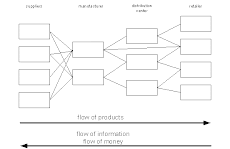
http://www.duke.edu/web/soc142/team1/graphic_valuechain.jpg
History of Supply Chains:
The history of supply chains begins in the 18th and 19th century where it was invisible and taken for granted. Naturally, Henry Ford, of Ford Dealerships, controls all the elements that feed his production lines. Tom Peters, who gave a presentation to major Ford dealers was struck by the fact that the convention center was built on the fields where Ford used to raise sheep to supply wool for its own automobile upholstery. Integration that now would seem crazy used to be seen as the only way to get things done. South Korean chaebols are great examples of this mentality. In a developing country, this makes sense but in a developed country it is nonsense. Flexibility is what gives the business supply chain its strength but also its vulnerability.
There is more to a supply chain than just managing it; just thinking about it sheds light on organizational development itself. Traditionally, companies had warehouse mentality, with security of supplies being the main requirement.
As a business idea, the supply chain was something with a life of its own. Which needed specialist management, developed in the 1990s, about the same time that the word “transportation” was replaced by “logistics.” The computerization of robotized warehouses enabled suppliers to lock their information systems into those of their customers. This created a truly integrated supply chain for the first time ever. Below is a diagram of a complex supply chain.

http://www.gscg.org:8080/opencms/export/sites/default/gscg/images/supplychain_complex.gif
This jolt from Japan also impacted supply chain management. When Western business people went to Japan, they discovered not only Total Quality and Continuous Improvements but also the interlocking relationships between large Japanese companies and their suppliers; these were often owned or funded by a common umbrella concern, so-called Keiretsu.
Huge manufacturers, such as the auto industry, were forced by cost pressures to re-examine their supply chain in the 1980s. A theoretically attractive new relationship was devised between big customers and smaller suppliers – long-term contracts, close supervision by the customer of the suppliers’ production line, system integration, joint working to improve the product and the way it was made – creating mutual benefits, not just an annual wrangle over the prices and quality.
In theory this could be a step change in industrial cooperation; many managers stated that they gained enormous advantage in learning intimately what their key customers wanted. However, the supply chain can be a nasty business when one partner gets a one-way advantage.
The supply chain is beginning to emerge as a point of differentiation for companies which have hitherto relied on their own brands and their own advertising.
The supply chain is moving from hidden provider to certified guarantor of good practice. This is a radical break from tradition! The impact of supply chains is faster than any legislation. Large companies are using the supply chain as an agent of change themselves. For example, if recyclable packaging is demanded or proof that child labour was not involved in whatever they are buying, it will happen.
The supply chain is changing; it is becoming a significant part of what is perceived to lie behind the branded good or service. When customers get even pickier, the supply chain will be forced to evolve again.
Supply Chain Management:

As warehouses were being reorganized, so were the supplies and suppliers. The pace of technological change was meaning that there was no longer security in having supplies in-house and on the shelf. For example, in the 1990s, semiconductor prices plunged from over $70 each to less than $1 in a single year! The supply chain became a threat to companies.
This jolt from Japan also impacted supply chain management. When Western business people went to Japan, they discovered not only Total Quality and Continuous Improvements but also the interlocking relationships between large Japanese companies and their suppliers; these were often owned or funded by a common umbrella concern, so-called Keiretsu.
Huge manufacturers, such as the auto industry, were forced by cost pressures to re-examine their supply chain in the 1980s. A theoretically attractive new relationship was devised between big customers and smaller suppliers – long-term contracts, close supervision by the customer of the suppliers’ production line, system integration, joint working to improve the product and the way it was made – creating mutual benefits, not just an annual wrangle over the prices and quality.
In theory this could be a step change in industrial cooperation; many managers stated that they gained enormous advantage in learning intimately what their key customers wanted. However, the supply chain can be a nasty business when one partner gets a one-way advantage.
Recently supply chains have begun to reverse themselves. When it comes to supply chains, computers make it real in a way that was not visible before.
The supply chain is beginning to emerge as a point of differentiation for companies which have hitherto relied on their own brands and their own advertising.
The supply chain is moving from hidden provider to certified guarantor of good practice. This is a radical break from tradition! The impact of supply chains is faster than any legislation. Large companies are using the supply chain as an agent of change themselves. For example, if recyclable packaging is demanded or proof that child labour was not involved in whatever they are buying, it will happen.
The supply chain is changing; it is becoming a significant part of what is perceived to lie behind the branded good or service. When customers get even pickier, the supply chain will be forced to evolve again.
Supply Chain Management:
Supply chain management is the synchronization of a firm’s processes and those of its suppliers to match the flow of materials, services, and the information with customer demand. A basic supply chain is shown below.

As the degree of customer interaction increases in the service process, the complexity and challenges often increase.

No comments:
Post a Comment